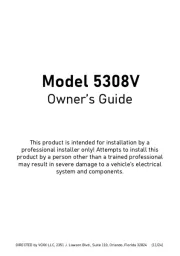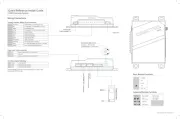Gemini 7833 Handleiding
Gemini
Auto alarm
7833
Bekijk gratis de handleiding van Gemini 7833 (7 pagina’s), behorend tot de categorie Auto alarm. Deze gids werd als nuttig beoordeeld door 67 mensen en kreeg gemiddeld 4.4 sterren uit 34 reviews. Heb je een vraag over Gemini 7833 of wil je andere gebruikers van dit product iets vragen? Stel een vraag
Pagina 1/7

For all EU Countries AC XXXX Rev. 04 - 08/07
UK
INSTALLER AND USER
MANUAL
7833
7832

2.0 - GENERAL NOTE FOR INSTALLATION
Dear installer, this manual has been written based on a complete system, therefore some functions,
electrical connections and other can be present in one alarm version and not in another.
In order to avoid repetitions in the manual, before installing the alarm, verify its version and then
follow the suitable instructions.
Furthermore, in order to carry out correctly the various procedures required, please
Device power supply (positive and ground).
Positive under key (+15/54)
Bonnet switch (if not on CAN-BUS line).
CAN-BUS line.
same as 7833 without self-powered battery.
VERIFY VERY
CAREFULLY ALL THE ELECTRICAL CONNECTIONS, IN PARTICULAR THE CONNECTIONS
LISTED BELOW:
GEMINI 7832:
!
!
!
!
PAGE 02
3.0 - FUNCTIONS
!
!
!
!
!
!
!
!
!
!
System arming and disarming by the vehicle original remote.
Acoustic arming/disarming signaling (excludable by programming).
Optical signalling (programmabili per inserimento e disinserimento se non presenti sul veicolo).
Perimetric protection.
Volumetric protection (excludable by arming).
Electrical engine immobiliser.
Negative output for additional siren.
Comfort negative output (about 20 seconds) or satellite system control.
LED memory.
Multifunction electronic key (random rolling code, 4,2 milliard of different codes).
Furthermore, in order to indicate to the installer and to the user some particular functions or
connections, an icon symbology has been used, which is briefly described below:
4.0 - OPERATING DESCRIPTION
PAGE 03
4.1 - COMPLETE SYSTEM ARMING
Press the lock button on the original radio control of the vehicle or insert the electronic key into the
specific receptacle.
Arming will be indicated by two short acoustic signals and by a number of optical signals (default
vehicles manufacturer setting).
Indications useful for the installer.
This icon indicates to the installer a diversificated operating, according to the connection
and the programming of the system or it simply provides indications useful for the
installation.
In case the vehicle has not optical signals when is closed, it is possible to activate these
signals by programming.
In this case, when the system is armed, two optical signals will be emitted
Indications useful for the user.
The user with indications for a diversificated use of the system or it simply provides
indications useful for the use.
!
!
4.2 - SYSTEM ARMING WITH SENSOR EXCLUSION
This function allows the user to arm the system, with volumetric protection excluded.
To active this function, the system must be disarmed and the ignition switched in “OFF” position and
than proceed as follows:
Turn the vehicle ignition key in “ON” position and wait for one second the status LED switches off
(the drivers door can be open or close at this point).
Introduce the electronic key into the receptacle; t
.
Turn the vehicle ignition key in “OFF” position.
!
!
!
he status LED will flash for one second and two
short acoustic signals will indicate the exclusion of volumetric sensors
When an immediate re-arming of volumetric sensors is required, switch the vehicle
ignition key in “ON” and “OFF” position.
1.0 - CONTENTS
1.0
2.0
3.0
4.0
5.0
6.0
7.0
8.0
9.0
11.0
12.0
16.0
- CONTENTS..... .......................................................................................................
- GENERAL NOTE FOR INSTALLATION..................................................................
- FUNCTIONS...........................................................................................................
- OPERATING DESCRIPTION.................................................................................
4.1 - Complete system arming......................................................................................
4.2 - System arming with sensor exclusion...................................................................
4.3 - Passive arming.....................................................................................................
4.4 - Arming inhibit time.................................................................................................
4.5 - System armed.......................................................................................................
4.6 - Alarm, inhibit time and alarm cycles.....................................................................
4.7 - System disarming.................................................................................................
4.8 - Emergency disarming by electronic key...............................................................
4.9 - Alarm memory.......................................................................................................
- ELECTRICAL CONNECTIONS..............................................................................
- CONNECTOR TABLE............................................................................................
- .............................................
- COMPLETE ELECTRIC DIAGRAM........................................................................
- SYSTEM PROGRAMMING............... ..................................................
...............................................................................................
........................................................................................
....................................................................
.........................................................................................
.................................................................................................
....................................................................................
................................................................
-.
.....................................
..............................................................................
WASTE ELECTRICAL AND ELECTRONIC EQUIPMENT (WEE) DIRECTIVE....
WARRANTY CONDITIONS...................................................................................
- TECHNICAL DATA...............................................................................................
CONNECTION FOR TURN SIGNALS ACTIVATION
...................
9.1 - Acoustic signalling
9.2 - Impulse optic signalling
9.3 - Optic signalling by arming/disarming
9.4 - System passive arming
9.5 - Negative comfort
9.6 - Satellite system activation
- SYSTEM PROGRAMMING EXAMPLE
VEHICLE CODE PROGRAMMING .....................................................................
- VEHICLE CODE PROGRAMMING EXAMPLE...............
- ADD NEW ELECTRONIC KEY
-
-
10.0
13.0
14.0
15.0
PAGE 02
PAGE 02
PAGE 03
PAGE 03
PAGE 03
PAGE 03
PAGE 04
PAGE 04
PAGE 04
PAGE 04
PAGE 04
PAGE 04
PAGE 05
PAGE 05
PAGE 06
PAGE 06
PAGE 07
PAGE 08
PAGE 08
PAGE 08
PAGE 08
PAGE 08
PAGE 08
PAGE 08
PAGE 09
PAGE 10
PAGE 11
PAGE 12
PAGE 12
PAGE 13
PAGE 13
UK

!
!
Press the lock button of the vehicle's original radio control or insert the electronic key into the
receptacle.
Two acoustic signals and the number of optical signals that has been programmed by the car's
manufacturer will indicate that the system has been armed.
Sensor exclusion is bound to the single arming cycle.
In case of alarm passive arming, internal sensors and comfort output will be excluded
(automatic window closing).
Moreover, the vehicle's door opening during the 60” before the passive arming, does not
inhibit activation.
4.4 - ARMING INHIBIT TIME
4.5 - SYSTEM ARMED
4.6 - ALARM, INHIBIT TIME ANDALARM CYCLES
4.7 - SYSTEM DISARMING
The inhibit arming time lasts for approxiately 40 seconds and is indicated by a illuminated status LED.
After the inhibit time (about 40 sec.), the system is “armed” and it is ready to detect any theft attempt.
When the system fully armed, the LED flashes.
After disarming the system, any occured attempt will be indicated by the alarm with visual/acoustic
signaling (see relative paragraph).
As mentioned before, the alarm will indicate any theft attempt by optical/acoustic signals, depending
on the system.
After the alarm has been triggered, before another alarm cause, there are 5 second of “neutral time”.
The alarm signalling has 7 cycles of 30” each for input and arming cycles.
The ignition key (+15/54) and the cut wire alarm signaling have no cycle limitation.
Press the unlock button on the original radio control of the vehicle.
Disarming is indicated by three short acoustic signals and by a number of optical signals, which have
been programmed by the vehicles manufacturer.
If an alarm condition has occurred, it will be signalled by five quick acoustic signals.
See relative paragraphs (4.9) for possible causes and signaling.
4.3 - PASSIVE ARMING
After the programming, the alarm is set to be passively armed, about 60” after the vehicle switching off.
PAGE 04 PAGE 05
In case the vehicle has not optical signals when is opened, it is possible to activate
these signals by programming.
In this case, when the system is disarmed, three optical signals will be emitted
!
4.8 - EMERGENCY DISARMING BY ELECTRONIC KEY
This kind of disarming has been conceived as an “EMERGENCY DISARMING” and “TOTAL
DISARMING”.
When placing the electronic key into the specific receptable, the alarm system disarms and switches
OFF.
It will be not re-arm when the vehicle radio control is used.
It is possible to carry out the complete disarming procedure only when the system is
armed, during one alarm cycle or during the neutral time between two alarm cycle but
not during the arming neutral time.
To restore normal operation, it is necessary to put one time the electronic key into the
specific receptacle and again during the arming inhibit time (LED lighted on).
4.9 - ALARM MEMORY
In case of five acoustic signals occurring at the alarm disarming, thanks to the LED’s memory, it is
possible to identify the cause which has generated the last alarm condition.
To do this, turn the ignition key in “ON” position and look at the vehicle installed LED.
The LED will start to blinks, shown the last alarm condition.
The cause of the alarm will indicate for 5 times.
This indication can be interrupted by turning the ignition “OFF”.
The possible alarm trigger signaling are indicated in the table reported below.
LED SIGNALLING CAUSE OF ALARM ALARM CYCLE
NUMBER
7
Infinite
7
Infinite
7
Doors opening
Boot/bonnet opening
Cut wires
Volumetric sensors
Start attempt (+15/54)
LED ON (1second)LED OFF (2 seconds)
5.0 - ELECTRICAL CONNECTIONS
!
!
Connect the supply power positive of the system to the vehicle battery pole or to one of its
derivations.
Connect the supply power negative of the system to the vehicle's original earth point.
!
!
Connect the GREEN wire of the alarm wiring harness to the bonnet switch.
.
Connect the GREEN/BLACK wire of the system to the GREN/BLACK wire of the ultrasonic
sensor or hyperfrequency sensor.
If the signal is
present in the CAN-BUS line, leave this wire available
!
.
Verify the use of ORANGE and WHITE/RED wires, according to the alarm programming (see
installation specifications)
!
!
Verify carefully the wires of CAN-BUS line in the vehicle on which the installation is to be carried
out.
Follow with GREAT ATTENTION the instructions for CAN-BUS line connection; do not invert
CAN-H and CAN-L wires, otherwise the system will not work.
Before carrying out all electrical connections, disconnect the
and re-connect again after completion.
negative battery terminal
Available diagrams for specific vehicles can be downloaded on the web-site
www.gemini-alarm.com (private area).
!
!
Product specificaties
| Merk: | Gemini |
| Categorie: | Auto alarm |
| Model: | 7833 |
Heb je hulp nodig?
Als je hulp nodig hebt met Gemini 7833 stel dan hieronder een vraag en andere gebruikers zullen je antwoorden
Handleiding Auto alarm Gemini

15 Januari 2023

13 Juni 2023

12 Juni 2023

9 Juni 2023

15 Januari 2023

15 Januari 2023

7 Juni 2023

15 Januari 2023

4 Juni 2023

3 Juni 2023
Handleiding Auto alarm
Nieuwste handleidingen voor Auto alarm

8 September 2025

27 April 2025

9 April 2025

31 Maart 2025

11 Maart 2025

30 Januari 2025

7 Februari 2024

7 Februari 2024

7 Februari 2024

6 September 2023